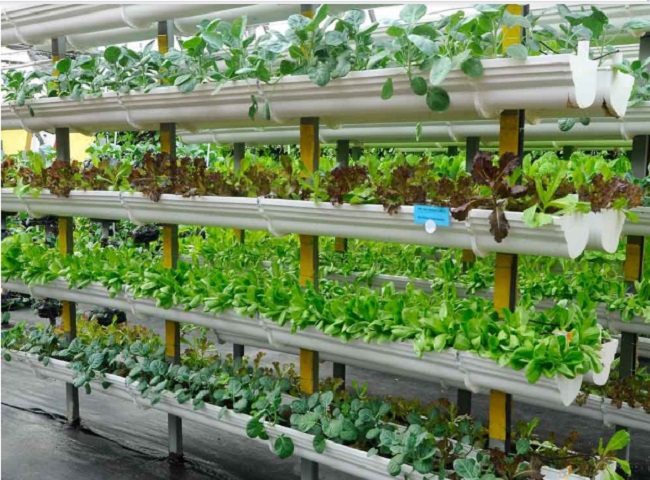As cities expand, populations grow, and farmland dwindles, traditional agriculture increasingly struggles to meet the demands of a growing nation. But what if we could grow food without relying on soil, unpredictable weather, or vast fields? Enter hydroponics, a revolutionary farming method that transforms even the most unlikely spaces into thriving agricultural hubs. Beyond addressing land scarcity, hydroponics offers a smarter, faster, and more sustainable way to produce food.
Hydroponics, which replaces soil with nutrient-rich water, is gaining global traction and beginning to take root in Nigeria. This technique allows plants to thrive with their roots suspended in water, air, or inert materials like coco coir or perlite, offering precise control over nutrients and environmental conditions. With urbanisation, land degradation, and climate change threatening traditional farming, hydroponics emerges as a compelling solution for the country’s food security challenges.
One of hydroponics’ standout features is its independence from soil, eliminating risks like soil-borne diseases. “No soil required means no risk of soil-borne diseases,” says Orji Emmanuel, agronomist and partner at GreenBloom Harvest Farm Ltd. This makes it ideal for areas with degraded or infertile land. Additionally, hydroponics is remarkably water-efficient, using far less water than traditional methods.
Controlled growing conditions also enable crops to grow faster. “Crops grow faster due to controlled growing conditions,” Emmanuel explains, emphasising the system’s efficiency. Hydroponics thrives in urban areas where space is limited and in regions with poor soil, making it particularly viable for Nigeria’s densely populated cities and arid zones.
In Nigeria, hydroponics has shown promise with crops like leafy greens, herbs, and fruiting vegetables. Lettuce, spinach, kale, basil, mint, tomatoes, cucumbers, and strawberries flourish in hydroponic systems with proper management of temperature and humidity. However, cost remains a consideration. “The only factor to consider is the cost of controlling the conditions necessary for its growth,” Emmanuel notes.
Adoption and Challenges
The adoption of hydroponics in Nigeria has grown steadily, driven by rising land costs, food security concerns, and demand for fresh, pesticide-free produce. Projections suggest hydroponic farming in Nigerian cities could grow by 15% between 2020 and 2030. Yet challenges persist.
Setting up hydroponic systems can be expensive, as most equipment, such as nutrient pumps and grow lights, must be imported. Unstable electricity supplies further inflate operating costs, with farmers often relying on generators or solar power. “Frequent outages increase operating costs,” Emmanuel adds.
Cultural resistance also poses a hurdle. Many traditional farmers view hydroponics with scepticism, hesitant to adopt methods so different from conventional practices. Similarly, consumer awareness remains low, but education and exposure to high-quality produce are gradually improving public acceptance.
Despite these barriers, hydroponics holds immense potential to strengthen food security in Nigeria. By enabling year-round production and efficient land use, it reduces dependence on food imports. “Hydroponics can reduce food imports by increasing local production of high-demand crops,” Emmanuel asserts, underscoring its role in stabilising supply chains.
Hydroponics also presents opportunities for rural and peri-urban farmers. Its efficient resource use, higher yields, and suitability for high-demand crops make it a viable option for regions grappling with climate variability. Additionally, it supports job creation and shields farmers from weather unpredictability.
Future Outlook
As Nigeria’s population is projected to double by 2050, traditional farming alone may struggle to meet food demands. Innovations like vertical farms, rooftop gardens, and low-cost hydroponic systems tailored to local conditions will be critical. Advances in automation, artificial intelligence, and aquaponics—combining plant and fish farming—can enhance hydroponics’ efficiency and affordability.
Government support will be essential to unlocking hydroponics’ full potential. Subsidies, local manufacturing of equipment, training programs, and awareness campaigns can lower entry barriers. Collaboration among farmers, suppliers, and policymakers will further strengthen the ecosystem.
Hydroponics is not a replacement for traditional farming but a complementary solution that addresses gaps, particularly for high-value and perishable crops. “Traditional farming will still dominate staple crops like grains, but hydroponics can fill gaps in high-demand, perishable crops, ensuring a resilient food system,” Emmanuel explains.
By learning from countries like the Netherlands, India, South Africa, and Kenya, Nigeria can fast-track its hydroponics journey. Though still in its infancy, the sector is poised for growth, with the promise of a more sustainable, secure food future for all.
As cities expand and traditional agriculture struggles to meet growing food demands, hydroponics, a revolutionary soil-less farming method, offers a sustainable alternative. This method, using nutrient-rich water and controlled environments, enables plants to thrive without soil, making it particularly valuable in urban areas with limited space and degraded land. In Nigeria, where food security is a concern, hydroponics is gaining traction, with crops like leafy greens and vegetables being successfully cultivated. Despite challenges such as high setup costs, imported equipment, and cultural resistance, hydroponics holds potential for year-round production and reduced dependence on imports.
Hydroponics also offers opportunities for rural and peri-urban areas, with its efficient resource use and high yields making it viable for regions facing climate variability. Supporting its growth, government interventions such as subsidies, local equipment manufacturing, and training programs are crucial. While not a replacement for traditional farming, hydroponics complements it by filling gaps for high-value and perishable crops. As Nigeria prepares for a population surge by 2050, innovations like vertical farms and aquaponics, coupled with global learning, can enhance hydroponics' role in ensuring a resilient and secure food future.






